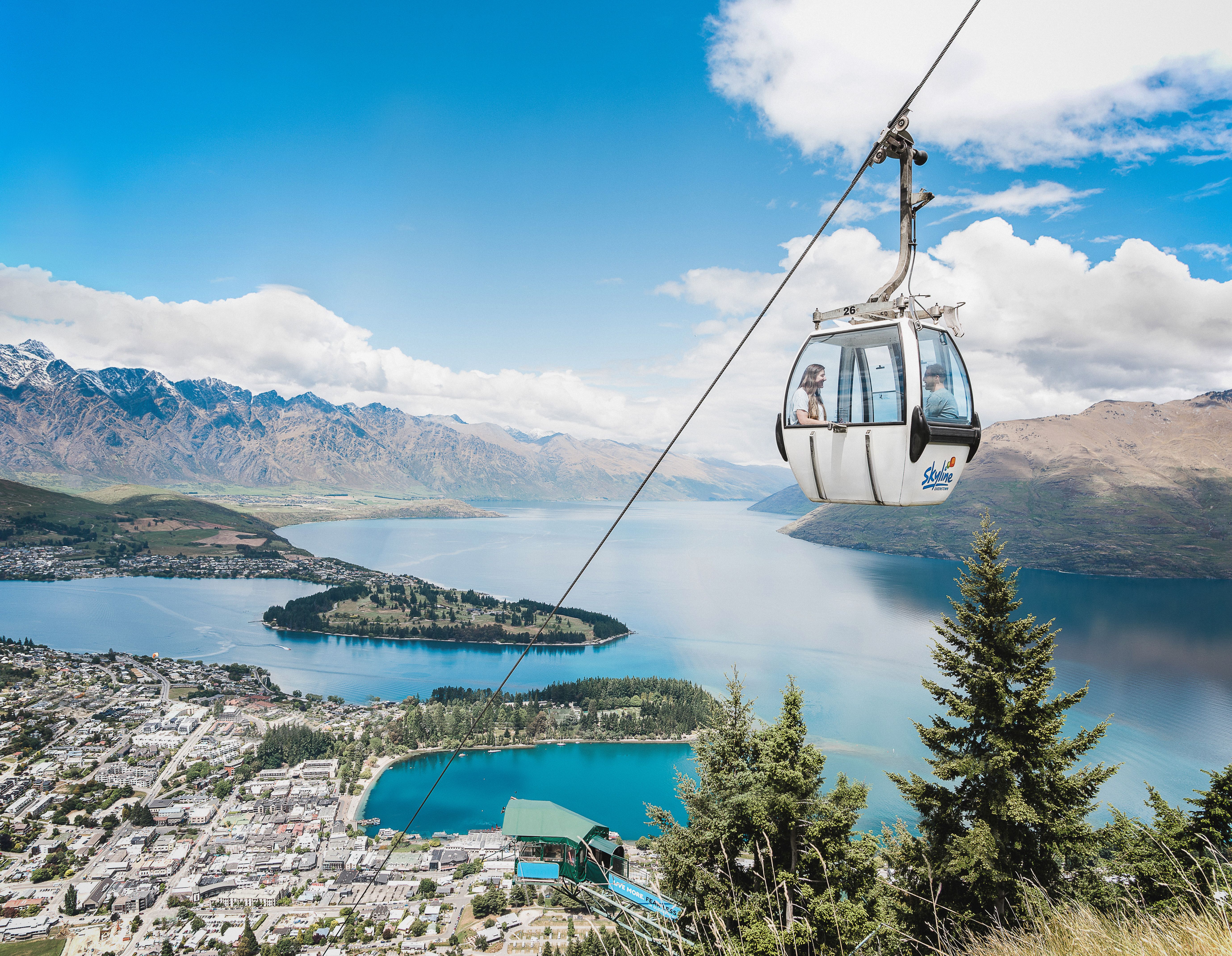BEST VIEWED IN LANDSCAPE MODE ON MOBILE DEVICES
U.S.FTC GUIDELINES PLEASE NOTE: we act as an affiliate for several companies that feature on our website. In some cases we may earn a commission from referrals to those companies. For further information please refer to our Privacy and Disclaimer policies which can be found in the "About" tab.
U.S.FTC GUIDELINES PLEASE NOTE: we act as an affiliate for several companies that feature on our website. In some cases we may earn a commission from referrals to those companies. For further information please refer to our Privacy and Disclaimer policies which can be found in the "US" tab.
Here's how to get from Wellington to Queenstown
First-timer’s guide: how to get from Wellington to Queenstown, New Zealand
Are you wondering about the best way to get from Wellington to Queenstown? Here's all the information that you will need.
Queenstown
sits at the heart of New Zealand’s Southern Alps on Lake Wakatipu,
while Wellington is the country’s capital at the southern tip of the
North Island. Between them lies the Cook Strait and some of the most
dramatic landscapes in the country. If this is your first time making
the trip from Wellington International Airport (WLG) to Queenstown
(ZQN), you have four main ways to go: fly, combine rail with the ferry
and a coach connection, take long-distance buses with the ferry in
between, or rent a car and drive (with a ferry crossing).
Each option
has its own rhythm, costs, and highlights. This guide explains how they
work, who operates them, how long they take, and what to expect so you
can choose confidently.
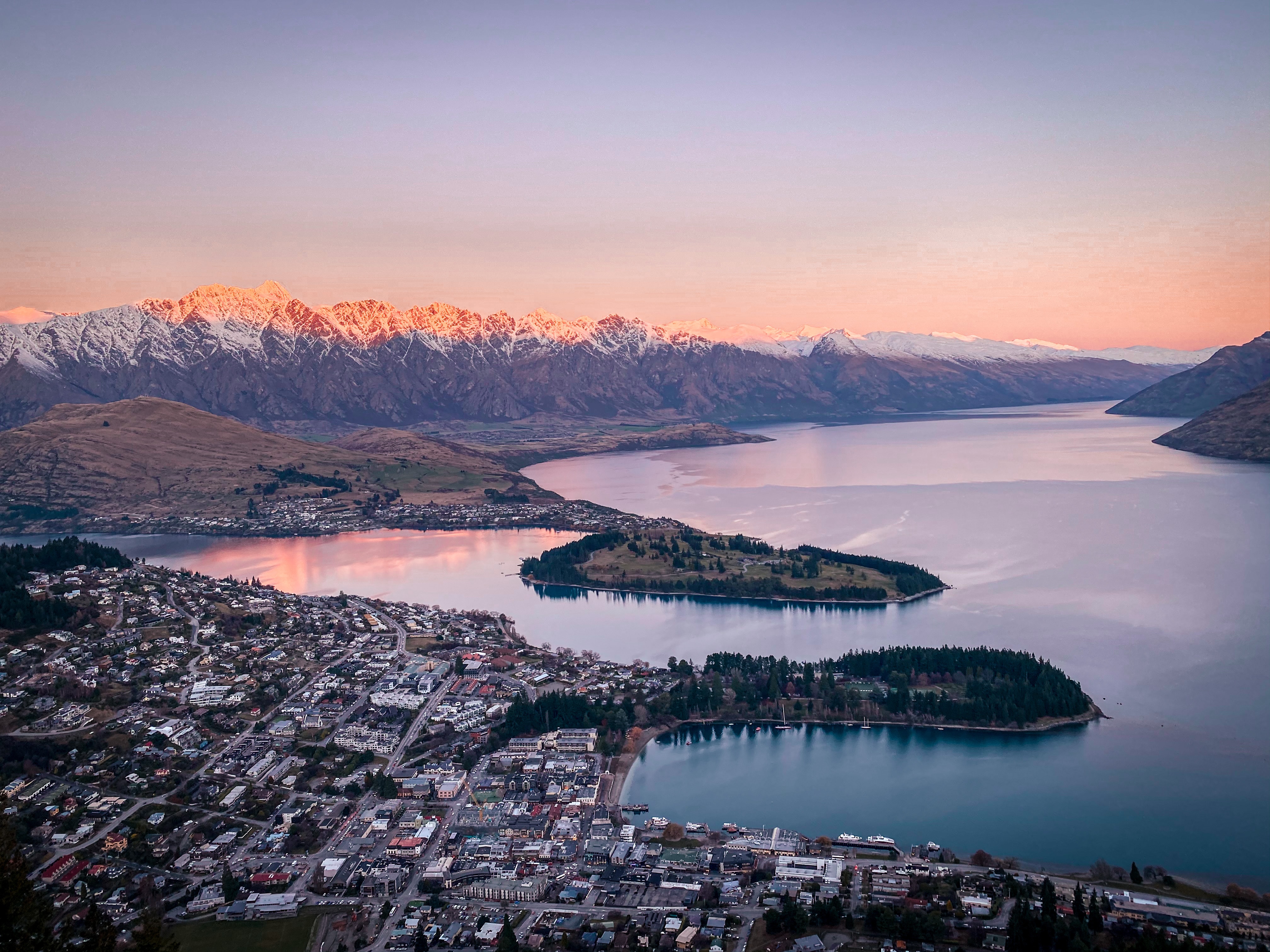
Use the links below to navigate around the page
Wellington to Queenstown - start and end points
Wellington International Airport (WLG)
- Location: Rongotai, about 8 km from Wellington’s city center.
- Terminals: One compact terminal handling both domestic and international flights. Easy to navigate; domestic and international areas are connected within the same building.
- Getting between the airport and the city or ferry terminals:
- Airport Express bus (Route AX): Frequent service between the airport, Courtenay Place, Lambton Quay, and Wellington Railway Station. Buy tickets on board with card or via Snapper card.
- Taxi and rideshare: 15–25 minutes to the CBD in light traffic; longer at peaks.
- To the ferry terminals: From Wellington Railway Station, Interislander operates a free shuttle to its Kaiwharawhara terminal for foot passengers. Bluebridge’s terminal is a short distance from the station (allow extra time to walk or take a taxi).
Queenstown Airport (ZQN)
- Location: Frankton, about 8 km from central Queenstown.
- Getting into town:
- Orbus Route 1 public bus: Frequent service to/from downtown; cheapest option (discounted with a Bee Card).
- Shared shuttles (e.g., Super Shuttle): Door-to-door for a moderate price.
- Taxis and rideshare: Fastest but most expensive; 10–20 minutes depending on traffic.
- See our Queenstown Airport page here.
Option 1 Wellington to Queenstown: Fly — the fastest and simplest
How?
A domestic flight from Wellington to Queenstown. If
time matters most or you want an easy, same-day transfer, this is the
clear winner.
Who flies the route
- Air New Zealand: Operates nonstop flights between Wellington (WLG) and Queenstown (ZQN) on selected days and seasons, and frequent one-stop options via Christchurch (CHC) or Auckland (AKL).
- Jetstar: Typically offers services between major centers with connections to Queenstown via Auckland or Christchurch; check current schedules, as direct services can change by season and year.
Typical travel times
- Nonstop WLG–ZQN: About 1 hour 30 minutes to 1 hour 45 minutes of flight time.
- One-stop via Christchurch or Auckland: Usually 3 to 5 hours total air time, plus connection time. Door to door from Wellington Airport to Queenstown town center often lands in the 4.5 to 7 hour range depending on layovers and ground transfers.
Pros
- Fastest and least complicated.
- Spectacular scenery on approach to Queenstown on clear days. Window seats on the left side heading south often deliver dramatic mountain views.
Cons
- Weather can affect Queenstown operations, especially in winter or when low cloud hangs in the valley; minor disruptions are possible. Build a buffer if connecting to international flights at the end of your trip.
- Basic domestic fares may not include checked bags or seat selection; check fare inclusions.
Practical tips for fliers
- Check-in and security: For domestic flights in New Zealand, aim to arrive 60 minutes before departure (more if you need to check bags or travel at peak times).
- Seat selection: If views matter, pick a window and check the forecast; afternoon flights can be glarey but still beautiful.
- Onward transport on arrival: If you’re budget-conscious and not in a rush, Orbus Route 1 is excellent value. For groups with luggage, shared shuttles are a good compromise between cost and convenience.

Option 2 Wellington to Queenstown: Ferry then Rail then coach — the scenic “Great Journeys” route
What is it?
There’s no passenger rail that runs directly
from Wellington to Queenstown, but you can make a highlight-filled
journey by crossing the Cook Strait by ferry to Picton, then taking the
Coastal Pacific scenic train down to Christchurch, and finishing with a
coach service to Queenstown. This turns your transfer into a memorable
three-day trip (or two, if you push), with time to enjoy the scenery and
a couple of vibrant cities along the way.
Key providers
- Ferry: Interislander (by KiwiRail) and Bluebridge operate between Wellington and Picton. Both carry foot passengers; Interislander also runs a free shuttle from Wellington Railway Station to its terminal.
- Scenic trains: Great Journeys of New Zealand (operated by KiwiRail) runs the Coastal Pacific between Picton and Christchurch on selected days and seasons.
- Coach (bus): InterCity operates long-distance buses, including Christchurch to Queenstown. Great Journeys sometimes offers through-tickets that include train and connecting coach segments—check their packages.
Typical itinerary and travel times
Day 1: Wellington to Picton by ferry
- Ferry time: 3 to 3.5 hours across the Cook Strait and through the Marlborough Sounds.
- Check-in: Foot passengers should arrive 45–60 minutes before departure; vehicles 60+ minutes. Weather in the strait can be lively; if you’re prone to seasickness, choose a calm-day sailing when possible.
- Overnight in Picton or take an afternoon train if timetables and your arrival line up.
Day 1 or 2: Picton to Christchurch by Coastal Pacific train
- Train time: Around 5 to 5.5 hours along a stunning coastal route past Kaikōura.
- Notes: Frequency varies by season. In summer, services most days; in shoulder/winter, fewer days per week. Book well ahead in peak season.
- Overnight in Christchurch.
Day 2 or 3: Christchurch to Queenstown by coach
- Bus time: Typically 7 to 8 hours via Lake Tekapo, Twizel, and Cromwell. Expect rest stops and a lunch break; the scenery across the Canterbury Plains into Mackenzie Country is superb.
Variations and add-ons
- TranzAlpine option: Add an extra day in Christchurch to ride the TranzAlpine to Greymouth (one of the world’s great scenic rail journeys) and then continue to Queenstown over the West Coast by coach over one to two days.
- Reverse pacing: If Coastal Pacific timings don’t suit, you can ferry to Picton, take a bus to Christchurch, then train a different day (or skip the train entirely).
Pros
- The most scenic public-transport route, with panoramic rail carriages and informative commentary.
- Breaks the journey into enjoyable segments with time to explore Wellington, Picton, and Christchurch.
Cons
- Requires more days and careful timetable coordination, especially outside peak season.
- More expensive than bus-only, usually cheaper than last-minute flights if you’re booking late in peak season, but pricing varies.
Booking and timing tips
- Check Great Journeys of New Zealand for current Coastal Pacific schedules and packages; look for combinations that include the ferry and the Christchurch–Queenstown coach segment.
- Align your ferry arrival with the train departure. If it’s tight, build in an overnight in Picton to reduce stress and enjoy the Marlborough Sounds or nearby wineries.
- In peak months (December–March) and school holidays, ferries and trains sell out; book early.

Option 3: Wellington to queenstown via ferry and bus — budget-friendly overland
What it is
A series of long-distance buses with a
ferry crossing in the middle: Wellington to Picton by ferry, Picton to
Christchurch by bus, then Christchurch to Queenstown by bus. This can be
done in two full days if schedules align, but many travelers take three
days with overnights in Picton or Christchurch.
Main providers
- InterCity: New Zealand’s primary long-distance bus network. They cover Picton–Christchurch and Christchurch–Queenstown and offer through-booking on many segments. Kiwi Experience are another option to explore.
- Ferry: Interislander and Bluebridge between Wellington and Picton.
Typical route and travel times
Day 1: Wellington to Picton by ferry
- 3 to 3.5 hours sailing, plus check-in.
Day 1 or 2: Picton to Christchurch by bus
- 5.5 to 6.5 hours via the coastal route (SH1) through Blenheim and Kaikōura. Expect comfort breaks and a meal stop.
Day 2 or 3: Christchurch to Queenstown by bus
- 7 to 8.5 hours via Tekapo, Twizel, and Cromwell. Some services route via Dunedin or include transfers; check the specific timetable.
Total journey time across the two islands is typically 16 to 19 hours of travel spread over 2 to 3 days.
Pros
- Generally cheaper than trains or flying, especially if you book early or use a travel pass.
- You see a wide variety of landscapes without the stress of driving.
Cons
- Long hours seated and multiple legs to coordinate.
- You must make your own way from Wellington Airport to the ferry terminal (or to a city departure point), then manage connections on the South Island.
Booking and comfort tips
- InterCity FlexiPass: Pre-purchase travel by hours for flexibility on multi-leg trips; good value if you plan additional journeys in NZ.
- Seat selections are first-come, first-served; arrive early. Pack snacks, water, and a light layer—air-con can be cool.
- In summer and school holidays, book ferry and bus legs well in advance and avoid razor-thin connections.

Option 4: Self-drive — the classic New Zealand road trip from wellington to queenstown
How?
Rent a car in Wellington, take it across the Cook Strait
on the ferry (or drop your car in Wellington and pick up a new one in
Picton), and drive through the South Island to Queenstown. This can be
done in two full days at a brisk pace or stretched into three to five
days to savor the journey.
Rental car providers in Wellington
- International brands: Avis, Budget, Hertz, Europcar, Thrifty, Enterprise.
- Local brands: Apex, Ezi, GO Rentals, Omega, JUCY (often more budget-friendly).
- Ferry swap: Many companies don’t allow their vehicles on the ferry or charge extra. Most offer “ferry swap” arrangements—drop your car in Wellington, cross as a foot passenger, and pick up a new car in Picton on the same booking. This avoids vehicle ferry fees and reduces risk if sailings are disrupted. You can see options here.
Ferry details
- Interislander and Bluebridge carry vehicles and foot passengers.
- Vehicle check-in: Arrive 60–90 minutes before departure; foot passengers 45–60 minutes.
- Crossing time: 3 to 3.5 hours. The last hour through the Marlborough Sounds is especially scenic.
South Island route options and driving times
Fastest conventional route: Picton to Christchurch to Queenstown (2 days from Wellington)
Day 1: Wellington to Picton (ferry), then drive Picton to Christchurch
- Picton to Christchurch: 4.5 to 6 hours via SH1 through Blenheim and Kaikōura. Coastal views and possible wildlife sightings.
- Overnight in Christchurch
Day 2: Christchurch to Queenstown
- 6 to 7 hours via SH1/SH79/SH8 through Geraldine, Fairlie, Lake Tekapo, Twizel, and the Lindis Pass to Cromwell and Queenstown.
- Scenic highlights: Turquoise lakes Tekapo and Pukaki; optional detour to Aoraki/Mt Cook Village for short alpine walks.
West Coast scenic route: Picton to Queenstown via the wild coast (3+ days from Wellington)
Day 1: Wellington to Picton (ferry), then Picton to Westport or Punakaiki
- 3.5 to 5 hours driving via Nelson and the Buller Gorge.
Day 2: Westport/Punakaiki to Franz Josef or Fox Glacier
- 4 to 6 hours with stops at Pancake Rocks, Hokitika Gorge, and glacier viewpoints.
Day 3: Glaciers to Queenstown
- 5 to 6 hours over the Haast Pass, then via Makarora and Wānaka to Queenstown.
- Notes: This is one of NZ’s most beautiful drives. Build in extra time for short walks and viewpoints.
Inland alternative: Picton to Queenstown via Lewis Pass and Mackenzie Country (2–3 days)
- Picton to Hanmer Springs or Christchurch via SH63/65/7 (4 to 6 hours), then continue to Queenstown via Tekapo/Twizel (6 to 7 hours). Quieter roads and alpine scenery at Lewis Pass.
Pros of self-drive
- Maximum flexibility. Stop for photos, detour to wineries, soak in hot pools, or linger at lakes.
- A chance to see less-visited places between the main centers.
Cons of self-drive
- Fatigue risk, especially after flights. NZ roads are often narrow, winding, and slower than they look on the map.
- Winter (June–September) can bring ice or snow to alpine passes (Lindis Pass, Crown Range). Chains may be required and roads can close temporarily.
- Taking a vehicle on the ferry adds cost; ferry swap logistics add a step.
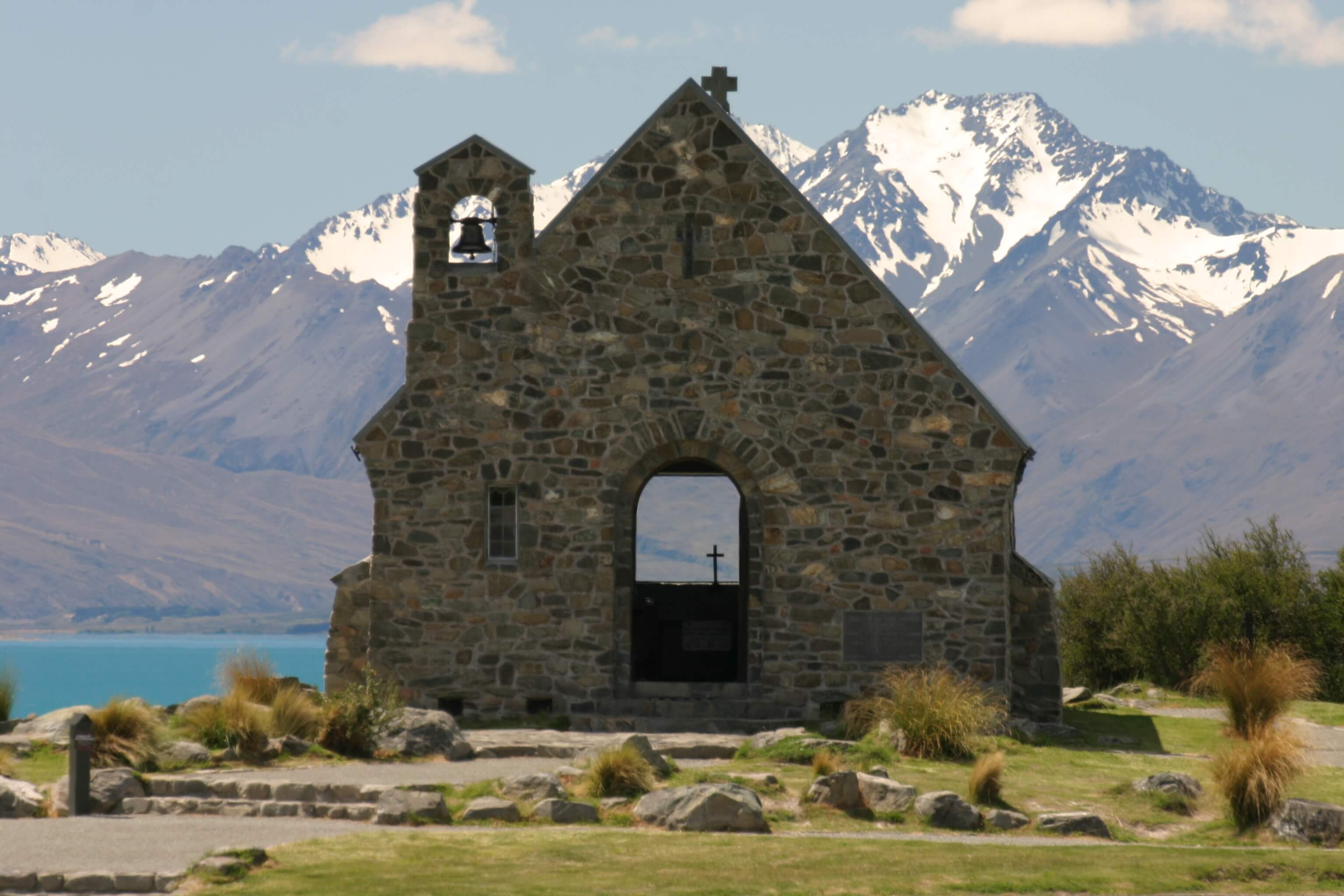
Option 5: A useful hybrid: fly-drive
If you don’t want the ferry or long North Island drives, consider flying Wellington to Christchurch (or Dunedin) and renting a car there for a South Island road trip to Queenstown.
- WLG to CHC flight time: About 50 minutes; frequent flights.
- Drive CHC to Queenstown: 6 to 7 hours in one day, or split with a night at Lake Tekapo or Twizel.
- WLG to DUD flight time: About 1 hour 10 minutes; services vary. Dunedin to Queenstown is 3.5 to 4.5 hours by car via Milton and Clyde or via the scenic Pigroot (SH85).
Driving tips for first-timers
- Drive on the left. Keep left, especially after turning.
- Speed limits: Usually 100 km/h on open roads; 50 km/h in towns. Drive to the conditions.
- Plan realistic days: 4 to 6 hours of actual driving can easily become 7 to 9 with sights and breaks.
- Check road conditions on the Waka Kotahi NZ Transport Agency website before long drives, particularly in winter or after storms.
- Fuel and food: Top up before remote stretches. Some towns close early.
- Chain control: If snow is forecast, carry chains and know how to fit them. If conditions are marginal, take lower, longer routes (e.g., via Cromwell rather than the Crown Range into Queenstown).
How to choose the best way to get from Wellington to Queenstown
- Fast and easy: Fly WLG–ZQN. If there’s no nonstop that suits, connect via CHC or AKL. Ideal if you’re on a tight schedule or want to maximize time in Queenstown.
- Scenic and immersive without driving: Rail + ferry + coach. Great if you value the journey and can spare 2–3 days.
- Budget overland: Ferry + InterCity buses over 2–3 days. Best for cost-conscious travelers who don’t mind long rides.
- Explorers and photographers: Self-drive with 2–5 days and a ferry crossing. You’ll stitch together many of the South Island’s signature scenes.
Practical planning and booking tips for your journey from wellington to queenstown
Seasonality and weather
- Summer (Dec–Feb): Peak demand. Book flights, ferries, trains, and rental cars early. Allow extra time for queues and connections.
- Shoulder (Mar–May, Sep–Nov): Often ideal weather and lighter crowds. Some train frequencies reduce outside summer.
- Winter (Jun–Aug): Ski season in Queenstown. Flight disruptions are slightly more likely during snow or low cloud. Road ice on alpine passes is possible; carry chains and check conditions daily.
Tickets and passes
- Air: Compare total price including bags and seat selection. Air New Zealand’s basic fares may not include checked baggage; Jetstar’s “Starter” fares are seat-only with add-ons.
- Ferry: Interislander and Bluebridge offer flexible and saver fares. Flexible fares are useful if you’re connecting from another service that could be delayed.
- Train: Great Journeys of New Zealand offers assigned seating; book early for window seats and to match train days with your ferry.
- Bus: InterCity sells point-to-point tickets and FlexiPass (by hours) for multi-leg trips. Passes can be cost-effective if you’re traveling more beyond Queenstown.
Luggage and comfort
- Domestic flights: Checked baggage may be extra. Standard allowances are usually 23 kg for a purchased checked bag; confirm your fare.
- Ferry: Generous allowances for foot passengers; if doing a rental “ferry swap,” pack so you can easily carry luggage on and off.
- Train: Luggage limits apply (commonly one large bag checked into the baggage van and one small carry-on). Confirm on booking.
- Bus: InterCity typically allows one large suitcase (up to around 23 kg) and a small carry-on; extra items may incur fees.
Connections and buffers
- Avoid tight same-day chains across different providers. For example, landing in Wellington and hoping to catch a ferry immediately is risky if your flight is delayed.
- If mixing ferry and train, consider an overnight in Picton or Christchurch to de-risk the connection and enjoy the towns.
Accessibility
- Ferries, trains, and many buses offer accessible options. If you use a wheelchair or have mobility needs, advise providers during booking to arrange assistance.
- In self-drive scenarios, confirm availability of suitable vehicles and note that some scenic attractions have uneven paths.
Money and payments
- Cards are widely accepted; contactless is standard. Carry a little cash for rural cafes or small operators just in case.
- Parking in Wellington and Christchurch can be metered or app-based; check signage.
Connectivity
- Mobile coverage is strong in cities and towns but patchier on remote stretches, especially on the West Coast and alpine routes. Download offline maps.
- Onboard Wi-Fi exists on some buses and trains but can be inconsistent in rural areas.
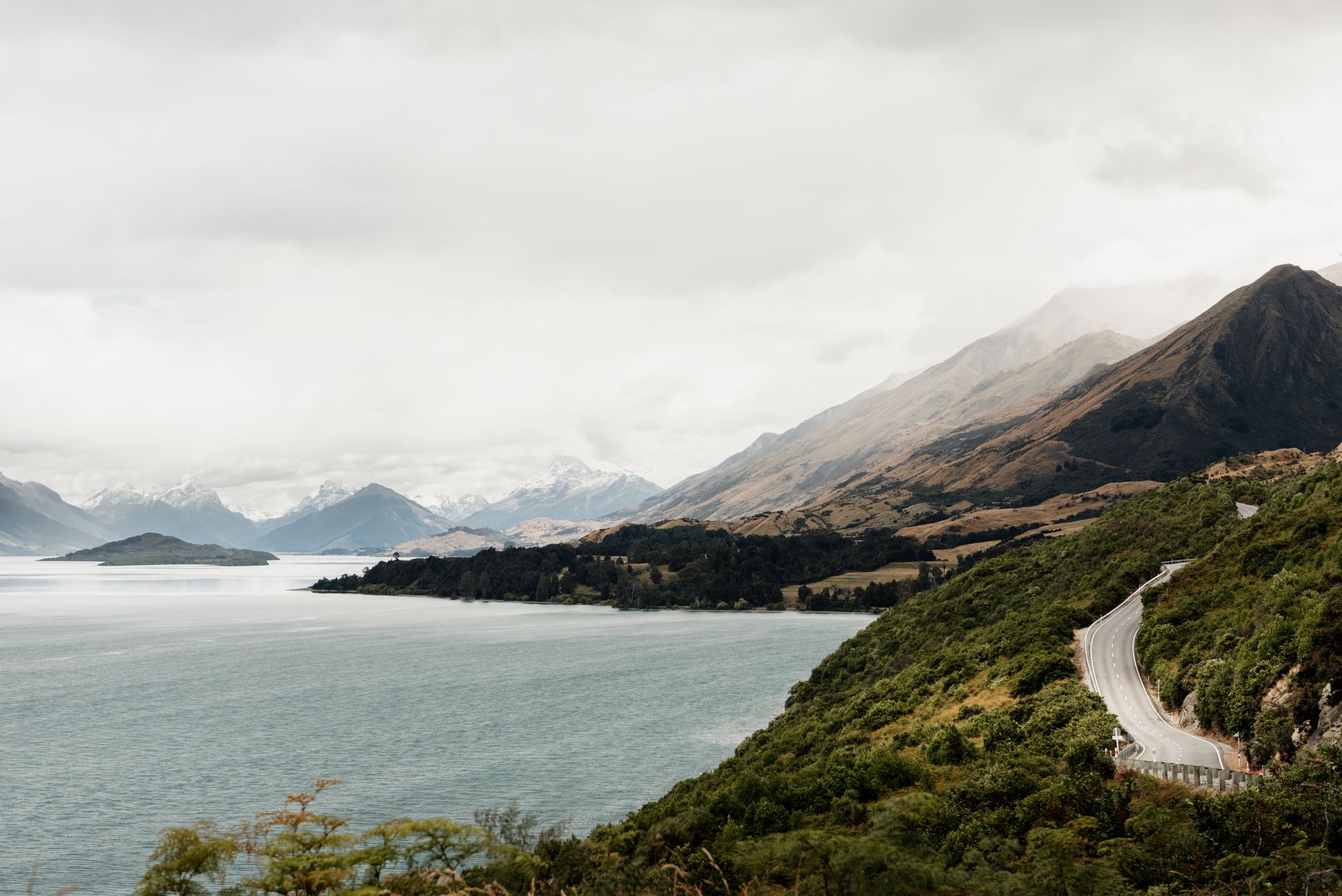
Sample itineraries
Fastest same-day
- Morning or midday: Fly WLG–ZQN (nonstop if available; otherwise via CHC).
- Early afternoon to evening: Land at ZQN; bus or shuttle to your accommodation.
- Total time airport to accommodation: Often 3.5 to 6 hours depending on routing and transfers.
Two-day scenic rail combo
- Day 1: Morning ferry Wellington to Picton. Afternoon Coastal Pacific to Christchurch (if schedules align). Overnight in Christchurch.
- Day 2: Morning InterCity coach Christchurch to Queenstown; arrive late afternoon or early evening.
Three-day relaxed overland by bus and ferry
- Day 1: Airport Express to Wellington city; ferry to Picton. Overnight in Picton.
- Day 2: Bus from Picton to Christchurch with a stop in Kaikōura for lunch. Overnight in Christchurch.
- Day 3: Bus from Christchurch to Queenstown via Tekapo and Twizel.
Three-day self-drive via Tekapo
- Day 1: Ferry with your car (or ferry swap); drive Picton to Christchurch. Overnight in Christchurch.
- Day 2: Christchurch to Lake Tekapo (3 hours). Afternoon at the lake, Church of the Good Shepherd, and Mt John lookout. Overnight in Tekapo.
- Day 3: Tekapo to Queenstown via Lake Pukaki and Cromwell (3.5 to 4.5 hours), with an optional detour up to Aoraki/Mt Cook Village for a short walk.
Four-day West Coast road trip
- Day 1: Ferry to Picton; drive to Punakaiki. Overnight.
- Day 2: Punakaiki to Franz Josef or Fox Glacier. Overnight.
- Day 3: Glaciers to Wānaka via Haast Pass. Overnight.
- Day 4: Wānaka to Queenstown via the Crown Range (if conditions are fine) or via Cromwell.
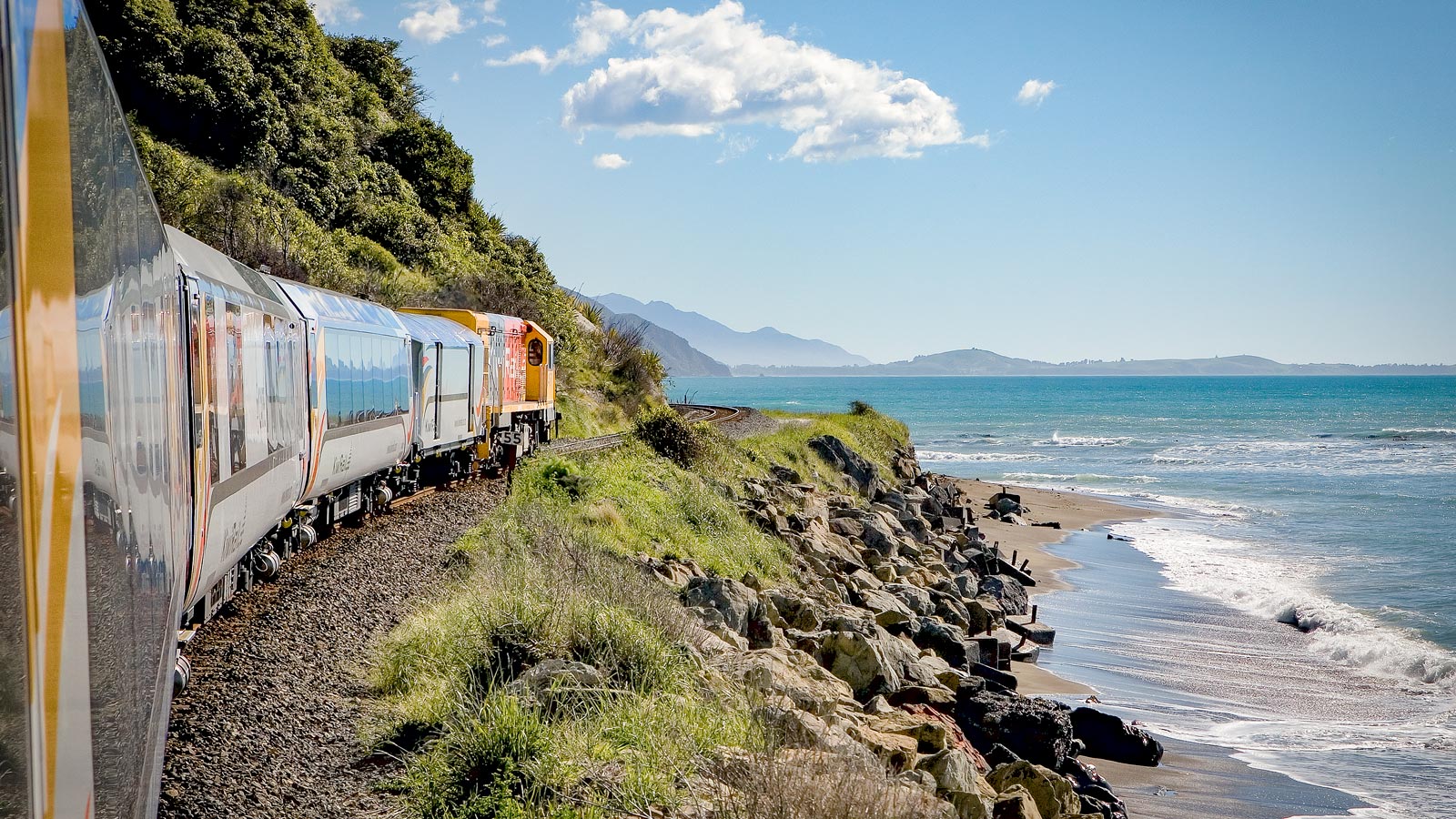
Providers
Air
- Air New Zealand
- Jetstar (connections; check current direct offerings)
Ferry
- Interislander (Wellington–Picton; free shuttle from Wellington Railway Station for foot passengers)
- Bluebridge (Wellington–Picton; terminal near the CBD and railway station)
Rail
- Great Journeys of New Zealand by KiwiRail (Coastal Pacific: Picton–Christchurch; TranzAlpine: Christchurch–Greymouth add-on).
Bus/Coach
- InterCity (Picton–Christchurch; Christchurch–Queenstown; other regional links, and Kiwi Experience as an option to investigate.
Final thoughts
For most first-time visitors, flying from Wellington to Queenstown is the smart, time-saving option—simple, efficient, and breathtaking on a clear day. If the journey is part of your New Zealand dream, the rail and ferry combination via the Coastal Pacific offers a showcase of coastal and alpine scenery with comfort and charm, while bus and ferry travel gives you a cost-effective overland adventure at a gentler pace. Drivers will find the self-drive route richly rewarding, especially when stretched over a few days to take in Tekapo’s turquoise waters, Kaikōura’s coastline, or the wild West Coast and Haast Pass.
Whichever path you choose, book key legs early in peak season, keep an eye on weather and road conditions, and build in a little flexibility. New Zealand rewards travelers who travel unhurried: a calm Cook Strait crossing at golden hour, a serendipitous seal sighting near Kaikōura, a clear view of Aoraki/Mt Cook from Lake Pukaki, or that first glimpse of the Remarkables as you descend into Queenstown. With the right plan, getting there can be as memorable as being there.
